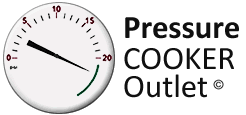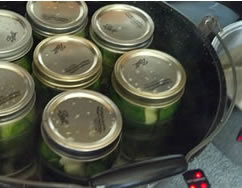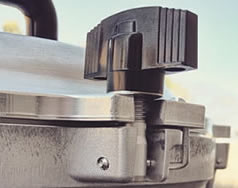Pressure Cooking and Canning Glossary |
|
| What's the big
deal about pressure cooking? |
Save
time, energy and money while eating better food. Plus, you're likely to know exactly what you’re
feeding your family. Whole grains, such as
wild rice or barley take no longer than 25-30 minutes in the
pressure cooker, compared to an hour on the stove. A whole
chicken cooks in 25 minutes. Shorter cooking time saves energy.
It can also mean savings when cooking with dried beans and
whole grains, which are less expensive than canned products.
A study in the March 2007 issue of the Journal of Food Science
found pressure-cooked broccoli retained 90 percent of its
vitamin C compared to 78 percent when steamed, and 66 percent
when boiled. By using very little water to cook, built-up
steam stays inside the pot with the food and all of the beneficial
nutrients. The lack of air keeps the flavors intact and colors
vibrant. Indeed, it's a handy item in the kitchen.
See our full line of Pressure
Cookers
|
| Water-bath
Canning (left) vs. Pressure Canning (All American on right) |
|
Water-bath canning is the easiest way to preserve food at
home. Acidic foods (with a pH of 4.6 or lower) can be processed
in a water-bath canner. Jars and the contents within are processed
at water's boiling point of 212 degrees Fahrenheit, destroying
molds, yeasts, and bacteria that cause spoilage.
Perhaps you're passionate about truly saving money, time
and electricity. For these savings and when you're ready to
eat more-nutritious foods, you'll graduate to pressure canning.
You can preserve all kinds of foods with a pressure canner.
From stew venison, roast beef, duck, and chili to green beans,
okra, beets, sweet potatoes, and asparagus, there's enough
mouth-watering meat, poultry, soups, stews, sauces, and vegetables
to keep you preserving food all season.
Pressure canning is used to kill food-bacteria and associated
micro life through increasing pressure to bring water's boiling
point to 250 degrees Fahrenheit. Since high acid food bacteria
are not a problem, there's no reason to use a higher temperature.
For low acid foods, problem microorganisms can be eliminated
by processing at 250 degrees for a certain amount of time.
This heat is achievable at home using the pressure canning
method. Since the mid-1900s we've known this temperature kills
the really nasty bacteria that cause things like botulism
or food poisoning. According to the July 2013 Mother Earth
News Issue, the Center for Disease Control and Prevention
has been tracking botulism since 1973 and the 2011 report
cited no deaths and only two cases of canning-related botulism.
For this type of food poisoning the risk is considerably low.
Once you learn the basics and follow tested time and pressure
home canning standards, you can focus on enjoying seasonal
flavors of watermelon pickles, mint jelly from apple juice
and sour kraut despite the season.
GraniteWare
Water-bath Canners - Pressure
Canners
|
| What bacteria
does pressure canning kill? |
According to Massachusetts
State College in a June 1944 study of process times for home-canned
foods, Clostridizcm botulism is the hardest to destroy
and causes botulism. Salmonella and Staphylococcus
are also noted to spoil preserves processed improperly, according
to Mrs. Wages Home Canning Guide and Recipes. |
|
| Canning may
have been risky for our grandparents. Problems with old equipment
that wouldn't be tested until it was way over due (how close
was the nearest land-grant university, again?). What's more?
Canning methods have been tested, retested, and tested again
to prove beyond reasonable doubt we can trust standards of
canning safety. After more than a century, pressure cooking
and canning is predictable and virtually foolproof if instructions
are followed correctly. Variations for time and pressure can
also deteriorate nutrients and taste of the food inside.
Today, the equipment is far better and finding
available factory made model-specific replacement parts, if
you shop with us, is a breeze. |
|
-
Read the instruction book
that came with your pressure canner or cooker and practice
assembling it properly.
-
Use trusted recipes for
pressure and proper cooking times. Add required liquid
first to the cooker/canner then add food or jars.
-
Canning? Start small with
six jars of jam or jelly. Have a large clean area for
working because canning takes a lot of space. Be prepared
with everything you need.
-
Hold cover toward a light
and look through the vent pipe to make certain it is open
and unclogged. Then place the cover on the cooker and
secure it tightly.
-
Place the pressure regulator
on the vent pipe. Adjust heat to maintain slow and steady
rocking motion or steam release.
-
Let the pressure escape
on its own after removing from heat, unless otherwise
stated.
-
The pressure is reduced
when the air vent/cover lock has dropped.
Canning Supplies
- Pressure Cookers - Pressure
Canners
|
|
All stainless
steel pressure cookers can be used on
induction stoves (this includes glass-top stoves). The
full Presto cooker and canner line is approved for use on
glass-top stoves (this includes their aluminum cookers). The
Chef's Design pressure cooker line is all stainless steel
and approved safe for induction stove use. The Ball water-bath
canner is the other product approved for induction stove use.
There are 10 pressure cookers, 2 pressure canners
and 1 water-bath canner that are safe for glass top stoves.

All
pressure cookers and canners safe for flat glass top induction
stoves
|
| How is cooking
time measured? |
Measured from the point
at which the correct level of pressure is reached. Achieving
a pressure is dependent on type of food in the cooker / canner
and will vary with each recipe. Always use a timer. Use high
heat to bring the pressure kettle up to pressure desired.
Then reduce the heat to maintain a steady level. |
| Does altitude
affect pressure cooking? |
As altitude increases,
the atmosphere's pressure decreases, and the temperature to
achieve water's boiling point decreases. According to the
Official Presto Pressure Cooker Cookbook, cooking times should
be increased by 5% for every 1000 feet above 2000 feet in
altitude.
View altitude charts
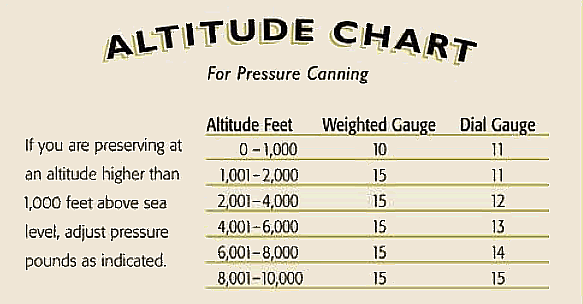
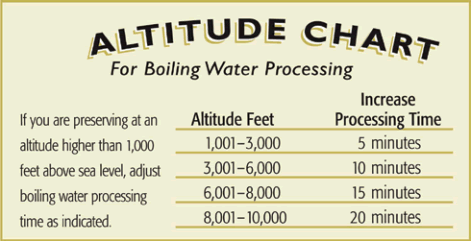
|
|
| When should a cooking
rack or basket be used? |
| Use a cooking
/ canning rack when you desire to keep all or some food out
of the cooking liquid. Foods kept out of the cooking liquid
maintain their unique flavor. Not using the cooking rack or
basket allows flavors to intermingle. |
| What is safe
to put inside a pressure cooker? |
| Presto's official
pressure cooker cookbook approves oven-proof glass, metal,
and ceramic dishes. Dishes should be filled two-thirds full
to allow for the expansion of foods and fitted loosely into
the pressure cooker, rack, or in the basket. |
| Is there
a difference when cooking just a little food in a pressure cooker?
|
| A small or
large quality of food may be cooked with the same fine results.
|
| What
methods clean aluminum and stainless steel cookers? |
| The outside
may be kept bright and shiny with a good silver polish or
simply washing with warm soapy water.
Iron and other materials in food and liquids can darken the
interior of a cooker or canner, although will not affect the
food being cooked in any way. These harmless stains may be
removed by using a solution of water and cream of tarter.
Enough should be used to cover the discoloration when poured
(not filling more than 2/3 full), then close the cover securely.
Heat until pressure regulator rocks gently. Remove cooker
from heat and allow to stand 2-3 hours. Remove regulator and
cover, empty contents and scour thoroughly with a steel wool
cleaning pad containing soap; wash, rinse and dry. |
| Stainless
Steel or Aluminum? |
| Aluminum is
lighter weight, lighter in color, and the best conductor of
heat. Stainless Steal is heavy duty with a nice and shiny
appearance that is more resistant to wear and abrasion. |
| Equipment |
- Be sure the condition of equipment is good.
Faulty gauges, pressure sealing gasket rings, or jars can
cause food to process incorrectly.
- Get your equipment together, laid out,
and within reach. Mid-way though pickling isn't the time
to remember you forgot lids and bands.
|
| Useful
Terms Defined |
Pressure Cooker
heavy pot with lid that locks, seals and pressurizes
when heated in any food with a required amount of
liquid rapidly cooking contents at 220 to 250 degrees
Fahrenheit
Boiling-Water Canner
pot deep enough for two inches of water covering standing
jars and additional airspace to prevent boil-over;
lid may aid continuous water boiling
Rack creates mason
jar stability when canning; separates food from liquid
within a pressure cooker; may be used with pressure-safe
dishes
Two-Piece Caps two-piece
vacuum sealing metal lid closures proven to be reliable
for home food preservation
Plastic storage lids
used to replace two-piece metal caps once a jar of
preserves is open with plastic cap designed for storage
since acidic foods, when exposed to air, can cause
metal to corrode and spoil food
Jar Lifter specialized
tongs that safely remove hot jars from canner
Jar Funnel makes
easy work of filling jars full of preserves to be
processed in a canner
Plastic Spatula
gently removes air bubbles that are trapped inside
jars
Lid Wand picks up
metal jar-lids from hot water with the magnetic tip
to be placed on jars
Wire Basket blanches
fruits and veggies easily
Food Mill puree fruits
and veggies, separate peels
Stone Crocks ferment
pickles and sour kraut before canning
Cheese Cloth
loosely woven cloth to be used as a spice bag or as
a strainer to separate pulp from juice.
Induction Stoves
heat a cooking vessel with induction heating, instead
of traditional heat transfer from electrical coils or
a gas flame. For nearly all models of induction cook tops,
which include glass-top stoves, a cooking vessel must
be made of a magnetic metal such as cast iron or stainless
steel. Copper, glass and aluminum vessels can many times
be placed on an interface disk which enables these materials
to be used.
|
|
|
|
